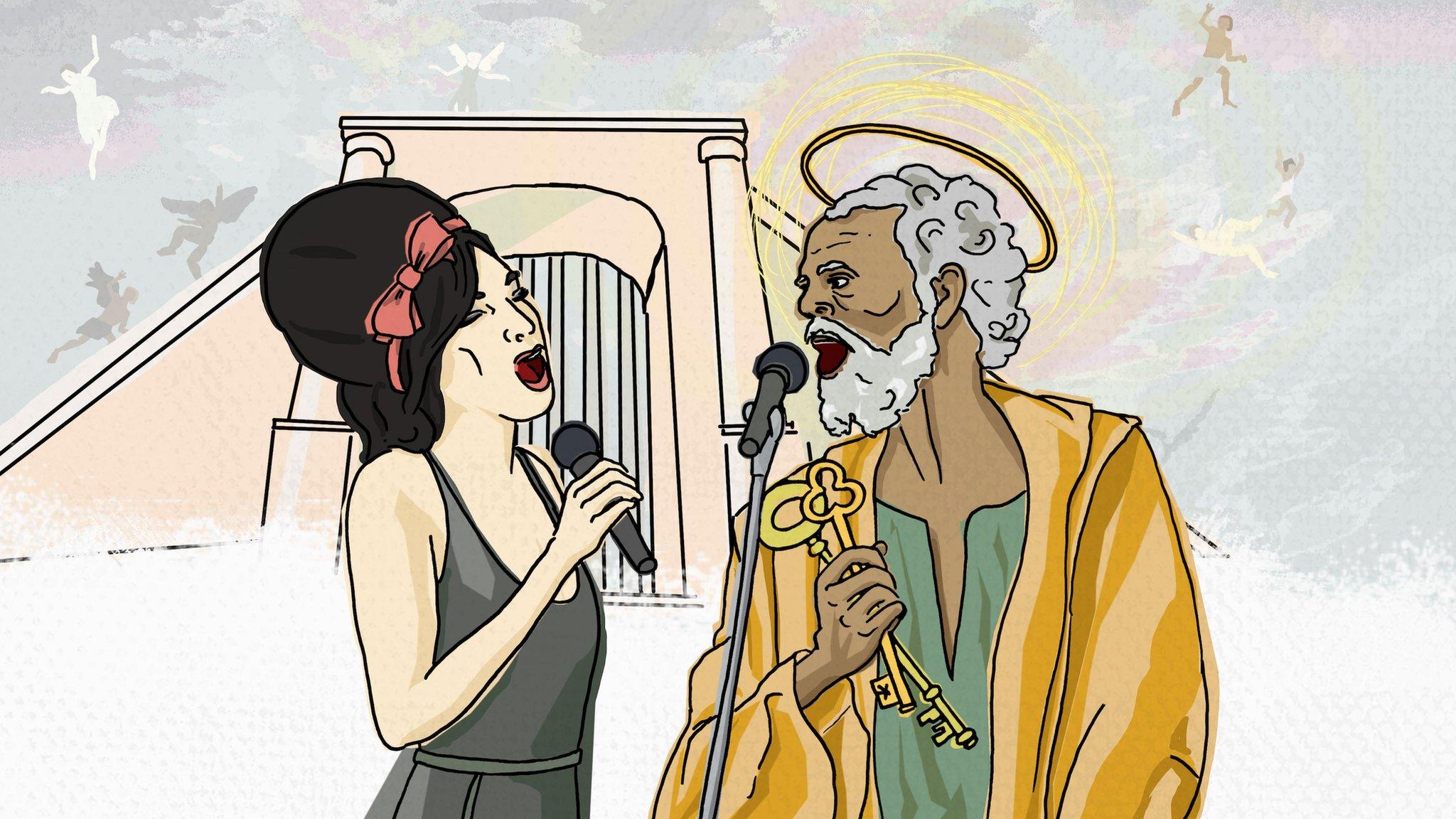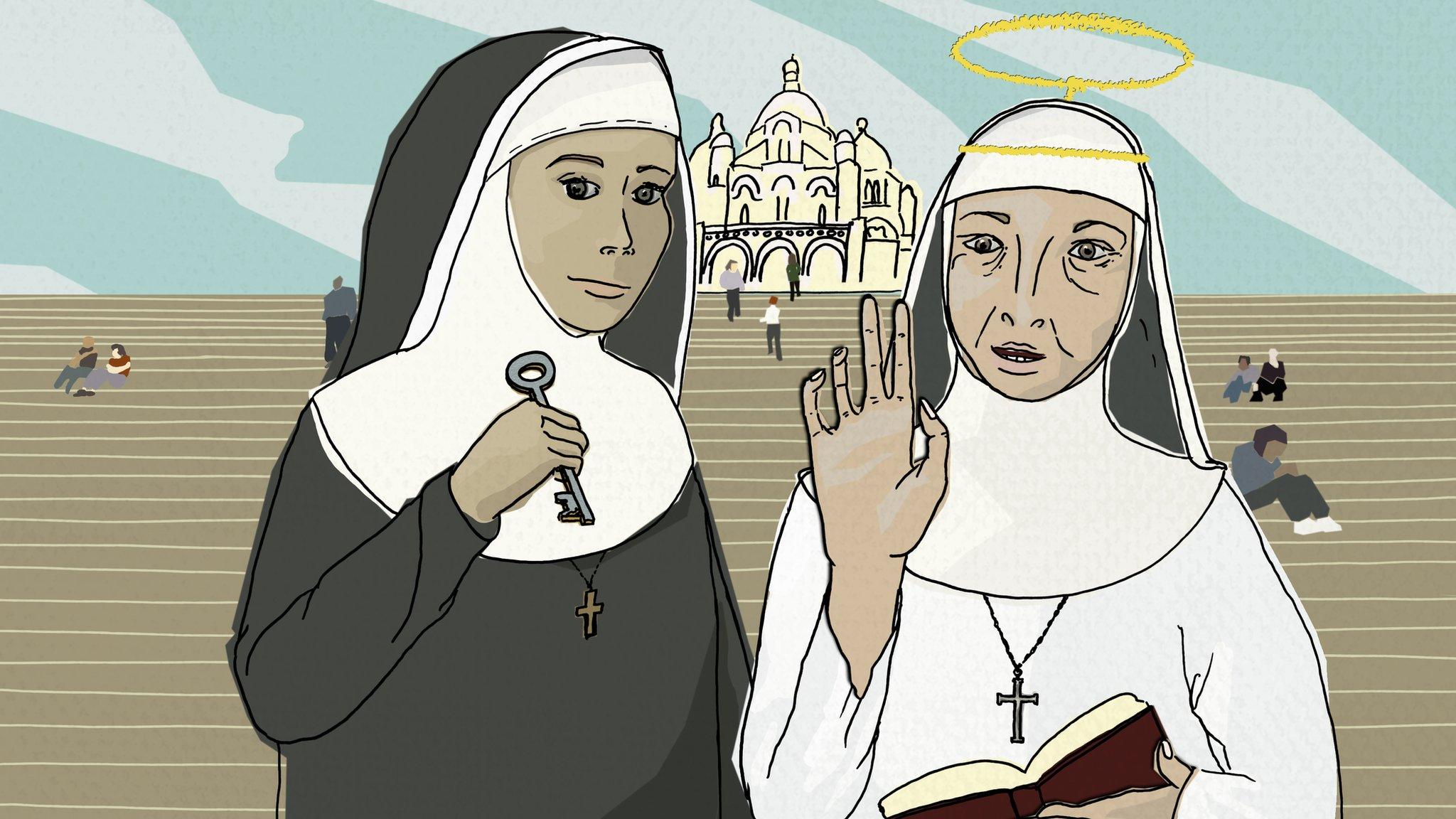The nun who prayed and made me walk
- Published
Life with a disability can sometimes give rise to unspoken questions and sensitivities, but amid the awkwardness there can be humour.
The following is an edited version of a monologue by Abigail Brown who has Osteogenesis Imperfecta, also known as brittle bone disease.

It was the summer of 2011, and my family and I were on holiday in Paris. I know it was 2011, because it was the same summer that Amy Winehouse died, which meant my holiday wardrobe consisted almost entirely of black gauze and winged eyeliner.
I devoted long hours to painstakingly translating French news articles with the help of my mother's 1983 French pocket dictionary, although it lacked crucial vocabulary around narcotics.
In addition to the dictionary I also inherited a genetic bone condition called osteogenesis imperfecta or brittle bones.
It's an inherently comic disability and means I can break bones in almost any situation, including - but not limited to - getting out of bed, watching rugby, learning to play the guitar or sneezing.
It doesn't just affect bones - it's like a lifelong game of Pokemon, except you collect medical conditions instead of adorable cartoon creatures. My mum and I both have short stature, spinal deformities and a rare form of hearing loss which, ironically, nobody has ever heard of.
My mum's mum is by far the fittest of the three of us and got hearing aids at the more sensible age of 72.
On a recent multi-generational trip to Pret A Manger, we found the music interfered with all six of our collective hearing aids and we baffled the barista by responding to: "Are you eating in?" with "Just a splash", "By card", and "Thanks very much". The barista felt so sorry for us she gave us a cup of tea on the house.
Like many people with brittle bones, I can stand, walk, and, if the mood takes me, dance like a 90-year-old with an arthritic hip. However, after 15 years spent using my two feet, my legs took themselves into retirement approximately 60 years earlier than the rest of me, and these days I only whip out walking on special occasions.
Back to 2011, which was the summer I started using a wheelchair for long distances. There's me and my family traipsing around Paris, my brother practicing wheelies with my wheelchair and me sweating profusely under all my black gauze.
We wind up in Montmartre to visit the Sacre-Coeur.
This landmark Catholic church was built at the highest point in Paris at the top of an extremely steep hill - with a kind of cable car system to transport wheelchairs, pushchairs, the otherwise disabled, the elderly and Americans halfway up the steps.
From there you either have to walk up the remaining steps or take a long and painfully cobbled route around the side of the hill to the top. Typical French Catholics - they do like to make sure you've put the effort in.

We were sitting at the top of the cable car section, admiring the view before attempting the steps, when a group of nuns appeared and began to set up for a short biblical play.
Unfortunately, the only member of my family who is both biblically literate and able to speak some French is my mother - who, as I've mentioned, is also severe-to-profoundly deaf.
While she made a valiant attempt to recall bible stories based on such visual clues as a nun brandishing an enormous key wrapped in aluminium foil at another nun dressed in a white cassock with a pipe cleaner "halo", the moral of the story was lost on us all and we remained unconverted, heathen Anglicans.
After the play, while mum fretted about whether the one with the tinfoil key was supposed to be St Peter or St Paul, the nuns passed out leaflets to the crowd.
There I sat, sweaty and despondent, in a desperately ill-fitting wheelchair, when a haloed, white-cassocked figure appeared above me.
Presumably mistaking my carefully curated mourning look for sorrow over my disability, the nun bent down and placed a reassuring hand on my shoulder.
"We pray for you," she said. "We pray your legs better."
In the six years since I began using a wheelchair, I've been prayed for multiple times, in multiple languages, by people of varying religions.
I don't know what the waiting time is supposed to be - whether prayers are supposed to be answered instantly, or whether there's some kind of triage system in place - but I'm still awaiting the day I leap out of bed in pain-free ecstasy and run to the top of Mount Sinai to sacrifice a goat.
That said, I would never be so bold as to say prayer doesn't work, I've just never seen one in action.
My legs were actually pretty good, in the grand scheme of things, that summer. It was my spine which was causing problems, so I felt a little uncomfortable accepting such heartfelt prayers on behalf of two unstable but really quite nice-looking legs from a stranger wearing a pipe cleaner halo.
I considered asking the nun whether I could re-direct the prayers to a more worthwhile cause. Whether she thought St Peter or St Paul would forgive Amy Winehouse's rampant drug abuse in the case of a six-time Grammy award-winner and Brit Awards' Best Female Solo Artist 2007.
Instead, I thanked the nun, wiped the sweat from my forehead, and probably gave her the best day of her religious career.
I stood up from my wheelchair and without a backward glance, I walked up the steps to the Sacre-Coeur.

Storytelling Live: Tales of the Misunderstood
Maura was one of seven people with a disability or mental health difficulty to perform a story about awkward moments as part of BBC Ouch's storytelling event at the Edinburgh Fringe Festival.
You can also read:
Look out for a special TV programme which brings all the tales together.
For more Disability News, follow BBC Ouch on Twitter, external and Facebook, external, and subscribe to the weekly podcast.


For more Disability News, follow on Twitter, external and Facebook, external, and subscribe to the weekly podcast.